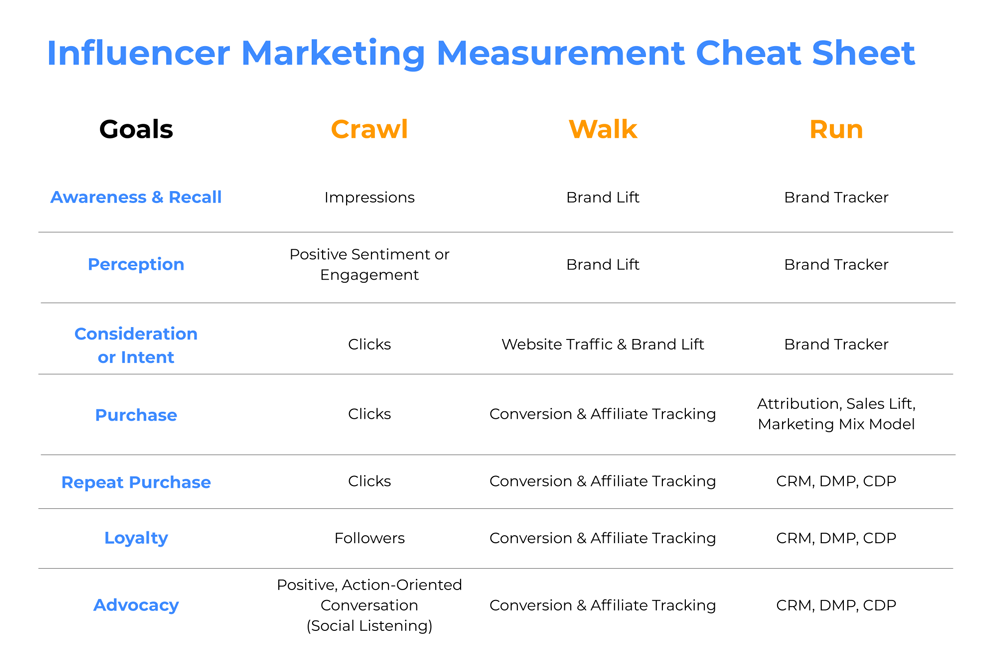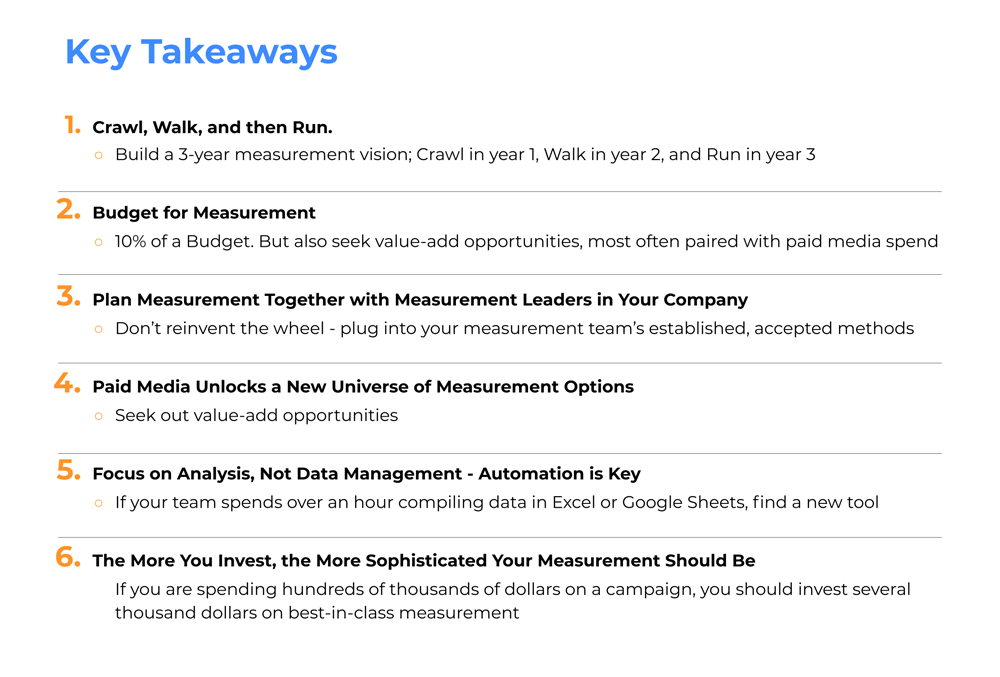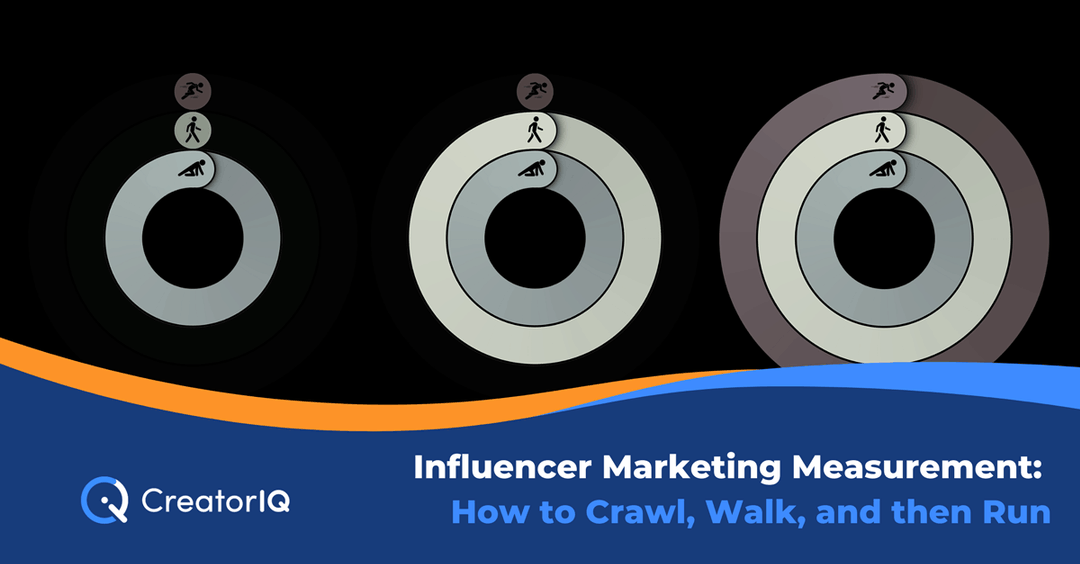There’s a well-established axiom in the business world—“What gets measured gets managed.”
As the influencer marketing space grows in size, complexity, and importance, it’s going to have to increase in sophistication as well. And that means measuring its impact with more science and accuracy.
Establishing a useful and meaningful measurement program—as well as the analysis around it—is a crucial step anyone engaged in influencer marketing should start taking now, before someone else measures (and manages) it for you.
We’re talking about more than just likes and clicks here. Influencer marketing has become too ingrained in overall marketing results to be treated as a niche activity. We’re talking about rigorous, repeatable, and scalable practices that elevate influencer marketing campaign metrics to the same level of importance and attention as other business KPIs.
That’s a lot. And it’s not going to happen overnight. So we put together this roadmap of where you should start, and where you need to go in the following stages—Crawl, Walk, Run.
Crawl
As the name suggests, this stage covers the very basics, but with a lens of establishing best practices that will position you for ongoing success. It’s likely that any influencer marketing effort is already tracking at least one of these metrics.
If you haven’t already done so, begin establishing a system for tracking these basics and familiarize your team with them. That includes likes, shares, engagement rates, and so on.
Some call them vanity metrics. But they’re only vanity metrics if they’re the only thing you measure and report. As you’ll soon see, these metrics are just the beginning, not the end.
The key to elevating these so-called “vanity” metrics is using them to establish a baseline of data that forms the foundation of what’s to come.
For instance, let’s say you tell your boss that an influencer marketing campaign generated 1 million views, with a 3.5% engagement rate, and resulted in $50k in revenue. Fantastic. Is that good or bad?
Benchmarking allows you to answer. Keeping a disciplined record of basic campaign performance allows you to determine averages and quickly identify outliers.
But keep in mind that these benchmarks will differ by channel, format, influencer tier, and even the vertical. The average engagement rate on Instagram will differ from that for TikTok and Facebook. Photos will perform differently than video. Fashion posts will perform better than pharmaceutical content.
So be sure you’re not only tracking and benchmarking, but doing so with granular context based on these variables. In time, these benchmarks will inform your storytelling and your campaigns, telling you which levers to pull to get the desired results.
After collecting and benchmarking the data, comes reporting. So now’s the time to make that process more efficient. For many, reporting has become a manual process, with 80% of the effort spent flipping from platform to platform, exporting data, importing it to Excel, and pasting into a PPT.
There are better ways. Many platforms (CreatorIQ included), offer simple automation that will import all the needed data into a reporting template that you can customize for your needs. The whole process takes about 5-minutes with a simple click of a button.
This allows you to use your time interpreting and learning from the report, rather than simply creating the report. Good reporting facilitates the development of good ideas. It tells its own story, which you can tell to others as well.
Once you’ve established your basic measurement, benchmarking, and reporting activities, you’re ready to stand up and start walking.
Walk
It’s easy to finish the Crawl activities and think you’re done, but in fact, it’s really just the beginning. That’s because the KPIs measured and reported in the first stage focus only on the performance of your influencer marketing campaigns and content. It’s looking inward in your own little room.
It’s time to emerge from that room and begin measuring campaign performance against business outcomes.
Consider this… if all you measure and care about is engagement stats, you could just post cat videos all day long. But unless you’re a cat grooming company, that engagement is unlikely to result in more sales.
Influencer marketing campaigns need to drive business results—sales, conversions, CTAs, etc. Yes, product-focused content and campaigns may get less engagement than cat videos, but it will be more meaningful to the company (and thus… your budget and your job).
So Walk is when you add impact metrics to your measurement activity. Think KPIs like conversion tracking, affiliate tracking, sales, and brand lift studies that connect influencer marketing efforts to tangible business outcomes.
Fortunately, this is a lot easier to accomplish in today’s environment. Social media platforms have introduced a host of features designed to help creators make money. And since creators make money when they make money for brands, you can use those same features to measure business outcomes.
We’re moving fast from a “link in bio” world to one where social commerce features are almost commonplace—Facebook Shops, Instagram Checkout, Instagram Affiliate, TikTok Jumps, and Shopify integrations.
The rise of social commerce is driving more robust and accurate measurement opportunities. And as more similar tools are developed for creators, the more need there is to measure those results.
If you’re not thinking about how to start Walking with these metrics, you will soon. Walk down the hall and start talking to the eCommerce team, the business intelligence team, your revenue analysts and your consumer research/data scientists. Learn how you can integrate their measurement practices into your efforts, and perhaps even vice versa.
Why? Because you need to start plugging your influencer marketing measurements into established practices within your company. Find out how they report their metrics up the chain and align with that. The more you can learn and adapt to their efforts, the better. Not only will it smooth your entry into the big leagues of company data, but you’ll start to become represented in those reports.
After all, their full-time job is to report up to the powers that be—the ones who make the decisions about your job and your budget—how marketing is going. So whether it’s one person or a team, track them down and make them your best friend. Because the more you learn from them and the more you can reverse engineer their models and assumptions, the better it will be for the discipline you own. Otherwise, you’re not even a line in that chart.
Run
Here’s where it gets really interesting. If what follows feels a bit much, relax… you won’t need to be here for another couple of years. But it’s good to see where all these efforts can eventually lead even if you’re still in the Crawl stage.
The Run stage simply amps up the measurement activity to the highest levels and deepest integration with overall business goals.
This includes:
Marketing Mix Models: Creating a multi-year regression model that supplies impressions data relative to sales in order to identify the content streams/campaigns that best correlate to sales over time.
Sales Lift Studies: Classed A/B testing where you determine if customers you know were exposed to communications/marketing content (the “campaign group) converted at a higher rate than a group that you know weren’t exposed (the “control” group).
Attribution Models: Models that determine how much credit an influencer campaign should receive for overall conversions/purchases relative to other marketing activities like display ads, search, email, and so on.
These are sophisticated modeling techniques that aren’t possible without first laying the groundwork in the Crawl and Walk stages. But this is your goal—creating a measurement structure that puts a real, defensible dollar figure connecting your influencer marketing efforts to company revenues. That gets you a seat at the table.
At-A-Glance
Here’s a quick cheat sheet that covers all three stages we just discussed:

How To Get There
Progressing through the Crawl, Walk, Run stages takes planning and patience. It won’t happen overnight.
To start, map out a three-year measurement vision, executing one stage a year. Then set aside 10% of your budget to support this. If you do it right, your budget will increase year over year, so that 10% will enable you to measure more as you go along.
Don’t forget to work with others in your company, whether it’s an individual or a team. Remember that the whole point of this is to integrate influencer marketing into the broader organization by using measurement and data to evangelize.
And finally… automate! Don’t get caught in the “busy trap” mistaking all the work put into manually compiling measurement reports as progress. It’s not. Automate reporting in order to create the time needed to learn from the results.
Here’s a quick roadmap to help keep you on track:

Conclusion
Influencer marketing is growing up… fast. As the C-suite takes note, both the opportunity and the accountability will increase. So the sooner you start to Crawl-Walk-Run, the better you manage the measurement of essential business KPIs, the more both you and your company will benefit as a result.
